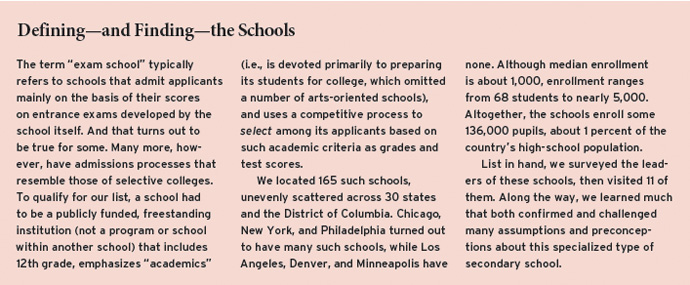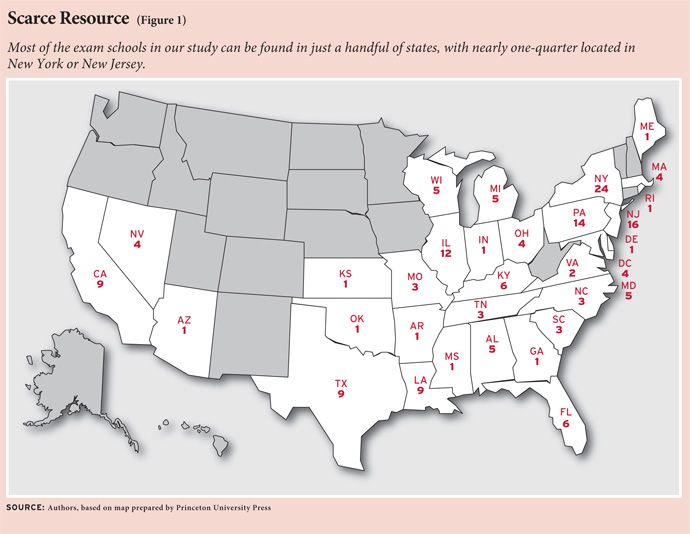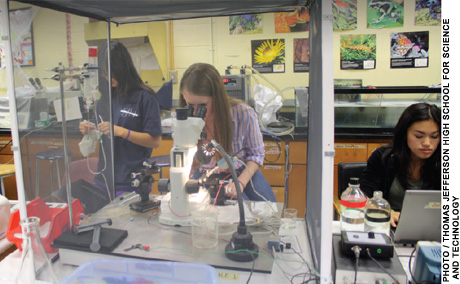 Stuyvesant. Boston Latin. Bronx Science. Thomas Jefferson. Lowell. Illinois Math and Science Academy. These are some of the highest-achieving high schools in the United States. In contrast to elite boarding and day schools such as Andover and Sidwell Friends, however, they are public. And unlike the comprehensive taxpayer-funded options in affluent suburbs such as Palo Alto and Winnetka, they don’t admit everyone who lives in their attendance area.
Stuyvesant. Boston Latin. Bronx Science. Thomas Jefferson. Lowell. Illinois Math and Science Academy. These are some of the highest-achieving high schools in the United States. In contrast to elite boarding and day schools such as Andover and Sidwell Friends, however, they are public. And unlike the comprehensive taxpayer-funded options in affluent suburbs such as Palo Alto and Winnetka, they don’t admit everyone who lives in their attendance area.
Sometimes called “exam schools,” these academically selective institutions have long been a part of the American secondary-education landscape. The schools are diverse in origin and purpose. No single catalyst describes why or how they began as or morphed into academically selective institutions. Some arose from a desire (among parents, superintendents, school boards, governors, legislators) to provide a self-contained, high-powered college-prep education for able youngsters in a community, region, or state. Others started through philanthropic ventures or as university initiatives. A number of them were products of the country’s efforts to desegregate—and integrate—its public-education system, prompted by court orders, civil rights enforcers and activists, or federal “magnet school” dollars.
Exam schools are sometimes controversial because “selectivity” is hard to reconcile with the mission of “public” education. Even school-choice advocates typically assert that, while families should be free to choose their children’s schools, schools have no business selecting their pupils. Other people are troubled by reports of insufficient “diversity” among the youngsters admitted to such schools.
With such criticisms in mind, we set out to explore this unique and little-understood sector of the education landscape. Wanting first to determine how many there are and where they are located, we also wondered whether the “exam school” could be a worthy response to the dilemma of how best to develop the talents of our nation’s high-performing and high-potential youth in a climate consumed with gap closing and leaving no child behind. Could the selective public high school play a larger role in educating our country’s high-achieving pupils?
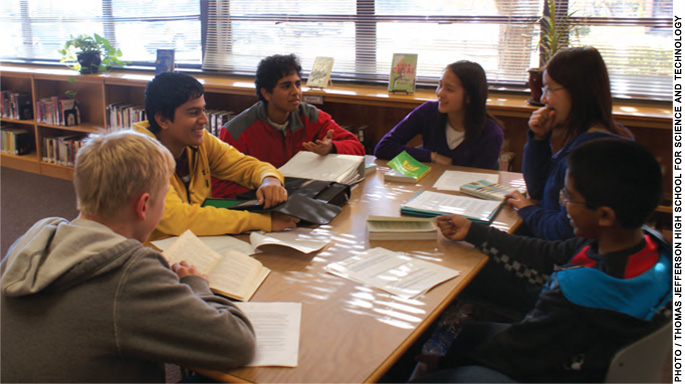
Who Goes There?
Almost all the schools have far more applicants than they can accommodate. Nearly two-thirds of those surveyed accept fewer than half of their applicants. About one-quarter also reported rising numbers of applications in recent years, perhaps due to media attention, awards, school performance, population growth, and the closing of underperforming schools in the area. Respondents also noted changes in the composition of their applicant pools, mainly increases in the number who are female, Asian, or Hispanic. Several schools reported a decrease in the number of white applicants in recent years. Nearly all schools we surveyed engaged in earnest, wide-ranging outreach to expand or diversify their applicant pools. A few also engage in “affirmative action” within the selection process.
The schools’ actual admission criteria and procedures are interesting, variegated, and somewhat sensitive. Some school officials are uneasy about the practice of selectivity, given possible allegations of “elitism” and anxiety over pupil diversity. Still, most rely primarily on applicants’ prior school performance and scores on various tests.
Viewed as a whole, selective public high schools have a surprising demographic profile. Their overall student body is only slightly less poor than the universe of U.S. public school students. Some schools, we expected, would enroll many Asian American youngsters, but we were struck when they turned out to comprise 21 percent of the schools’ total enrollment, though they make up only 5 percent of students in all public high schools. More striking still: African Americans are also “overrepresented” in these schools, comprising 30 percent of enrollments versus 17 percent in the larger high-school population. Hispanic students are correspondingly underrepresented, but so are white youngsters. Individual exam schools often qualify as racially “imbalanced”: in nearly 70 percent of them, half or more of the students are of one race.
Inside the Schools
The schools we visited were serious, purposeful places: competitive but supportive, energized yet calm. Behavior problems (save for cheating and plagiarism) were minimal and students attended regularly, often even when ill. The kids wanted to be there, and were motivated to succeed. (Bear in mind that many of the schools seek such qualities in their applicants.)
In general, the schools structured their schedules in ways that facilitate in-depth learning and prepare students for the typical college schedule: staggered start times, eight-hour days, class periods of varying lengths, fewer class meeting days per week, and dedicated time for collaborative and independent research projects. Most classrooms we observed were alive, engaged places in which teachers appeared to have high expectations for their pupils and planned their instruction around the assumption that students can and want to learn.
Most schools offered Advanced Placement (AP) courses or the International Baccalaureate (IB) program. Several noted that they “only offer honors and AP courses.” A few schools noted that students do not take AP courses per se, either because they take actual college classes (at host colleges or through dual-enrollment arrangements) or because they earn college credit for advanced courses taught within the school itself.
We also came upon other kinds of specialized and advanced courses, in addition to or in lieu of AP and IB. Schools with a STEM focus or university affiliations, for example, reported an array of upper-level science and math courses that few ordinary high schools—even very large ones—could offer. Among them were Human Infectious Diseases, Chemical Pharmacology, Logic and Game Theory, and Vector Calculus.
There’s lots of homework but ample extracurricular opportunities, too. We encountered literary magazines, robotics competitions, sophisticated music and theater offerings, most of the usual clubs and organizations, plenty of field trips, and no dearth of sports—though champion football and basketball teams were rare!
Our site visits revealed faculties consisting mostly of intelligent, dedicated individuals, well grounded in their fields. Turnover was low. Most teachers belong to unions and are paid on the “contract scale,” but many receive additional compensation for longer days and extra duties. They tended to come early, stay late, and design complex assignments and lesson plans that may take as much time for them to formulate and grade as for their students to complete.
One assumption about selective public schools is that they have more and “better” teachers. It turns out, however, that their pupil-teacher ratio is actually a bit higher (17:1) than in all public high schools (15:1). (One likely reason: not much “special ed.”) The percentage with doctoral degrees is higher, too (11 vs. 1.5 percent), as is the percentage with master’s degrees (66 vs. 46 percent.) Nontrivial numbers of teachers also have experience in industry, science, and universities.
Nearly two-thirds of survey respondents indicated that teacher-hiring decisions are made at the school level. As for the criteria they employ in selecting faculty, of greatest importance are subject-matter knowledge, pedagogical knowledge and expertise, and the ability to engage adolescent learners. Many schools also seek proven classroom-management strategies, compatible teaching philosophies, technology prowess, and collegiality. Some require demonstration lessons and interviews by current teachers (and sometimes students). And some criteria are clearly aligned with the schools’ singular missions and student bodies (e.g., PhD in biology, training in AP instruction, ability to work with gifted pupils).
The schools’ principals hailed from various backgrounds. As a group, however, they exhibited traits that one would expect of leaders of successful high schools that in some cases are the pride of their communities and in every case are closely watched: extraordinarily dedicated and hard-working individuals who are also politically astute.
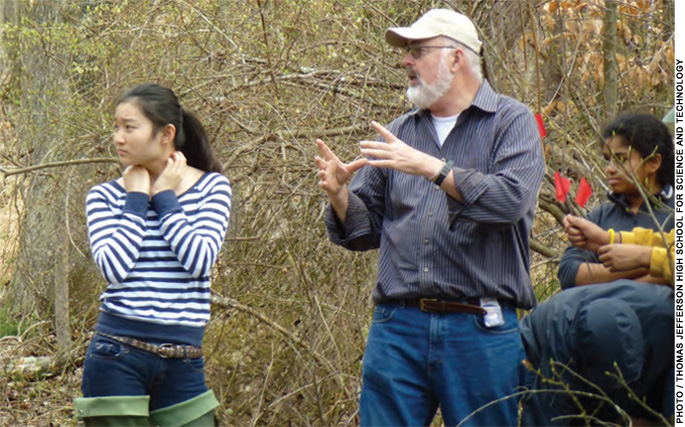
Governance and Finance
The schools are remarkably varied when it comes to history, mission, structure, and organizational arrangements. The oldest among them—New York’s Townsend Harris High School, Boston Latin School—have been around in one form or another for centuries, while half the schools for which we have such information are creations of the past two decades. With rare exceptions (mainly in Louisiana), however, the schools are not charters. Although they’re “schools of choice,” they are operated in more top-down fashion by districts, states, or sometimes universities rather than as freestanding and self-propelled institutions under their states’ charter laws.
We asked survey respondents about waivers and exemptions from the customary rules and regulations within which public schools operate. Because many of the schools on our list occupy distinctive niches within their local communities, districts, or states, we were also curious whether their teachers are fully subject to the provisions of collective-bargaining contracts. Most certainly are, but almost one in five is not (or not fully) subject to seniority-based staffing decisions.
A handful of responding schools said either that they are not required to hire teachers with state certification, or that other credentials (e.g., PhD in relevant field) preempt certification, at least for several years. In general, however, routine regulations and contract provisions prevail. We were struck by how few schools reported explicit freedom from them. Principals did say, however, that they could usually “work things out” as needed.
The schools vary widely in funding levels and other resources, from those that can barely make ends meet on per-pupil allotments that are lower than other high schools in the area to a few schools that amass large budgets from multiple sources and boast extraordinary technology and staffing. But all the schools we visited were worried about budget cuts associated with economic distress and pressure on state and local resources.
Leaders of these schools felt doubly vulnerable as attention—and resources—were concentrated on low-performing schools and students. (“Smart kids will do fine, regardless, and in any case are not today’s priority” was the undertone they picked up.) Many had become accustomed to having at least some extra resources, often for transportation or smaller classes. While some schools benefit from certain categorical funds (e.g., magnet dollars, STEM, or tech-voc dollars), many don’t qualify for other state and federal programs, such as Title I, bilingual education, and special education. Most engage in supplementary private fundraising to sustain resources for transportation, smaller classes, or other school features to which they and their students, parents, and teachers are accustomed.
Despite such challenges, the schools seem to enjoy levels of support that mitigate the budgetary distress and bolster their resilience. Most, for example, benefit—politically and in other ways, such as fundraising—from exceptionally devoted friends, sometimes in high places, including alums, local politicians, business and university leaders, even journalists. Many have ties with outside organizations, including universities, labs, and businesses, which bring expertise and some resources into the school, afford it some political protection, and supply it with venues for student internships and independent projects.
Some schools are also viewed as magnets for economic development and talent recruitment for their community or state. School-board members and district leaders believe that the presence of the school encourages middle- and upper-middle-class families to stay in town and stick with public education.
Perhaps most importantly, the schools are blessed with overwhelming advocacy from alumni and the parents of their students, many of whom feel that their children are receiving a private school–quality education at public expense. That parents strongly believe the schools provide safety (physical, emotional, intellectual), short- and long-term academic and career opportunities, and social benefits for their children will likely go a long way toward ensuring the survival of the schools, if not their expansion or replication.
The AP Quandary
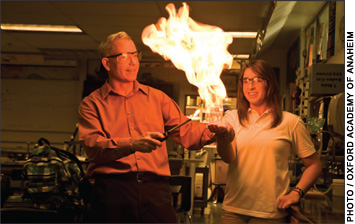
Nearly every school on our list offers a host of AP courses and has a huge number of students enrolling in them (either by requirement or by choice) and racking up solid scores on the AP exams. At northern Virginia’s celebrated Thomas Jefferson High School for Science and Technology, for example, students take an average of seven AP tests—four are all but universal—and do extremely well, earning scores of 3 or better on a mind-blowing 98 percent of the 3,357 AP exams that they sat for in 2010. Here and at many (though not all) schools on our list, students compete—and are pressed by parents—to rack up as many AP credits as possible.
Yet today’s scramble for entry into top-tier colleges plus the premium placed (by multiple players) on taking and passing AP exams plus standardized-test-based accountability pressures emanating from government do not add up to an optimal environment for these high schools. Here they don’t raise standards as much as they standardize. They press on students, parents, and teachers in ways that are plausibly said to discourage experimentation, risk-taking, unconventional thinking, unique courses, and individualized research, as well as pedagogical creativity and curricular innovation.
We spoke with frustrated teachers and exasperated administrators, well aware that they’re riding the back of an AP tiger from which it’s hard to dismount, especially for a public school that must weigh the priorities of parents, taxpayers, and voters. We talked with highly motivated students, too, who were (as one young man put it) “exhausted” from carrying course loads that included as many as six AP classes a semester in pursuit of a high school transcript that would wow the admissions committees of elite universities.
Some school leaders are pushing back, encouraging teachers to develop challenging courses that don’t fit the AP mold, or offering college-level courses shorn of the AP label. But only a few—such as the statewide, residential Illinois Math and Science Academy—have succeeded in putting their own stamp on the entire curriculum and withstanding the AP tsunami.
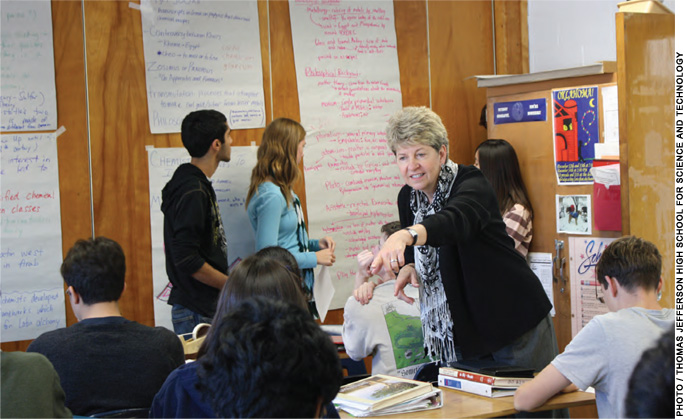
Are Exam Schools Effective?
The selection criteria employed by these schools all but guarantee students who are likely to do well academically, which raises the question of whether the schools’ generally impressive outcomes are caused by what happens inside them—their standards, curricula, teachers, homework—or are largely a function of what the kids bring with them. The schools’ peer culture likely has some influence on their pupils, too, as do high teacher expectations. Much like private schools, which are more apt to trade on their reputations and college-placement records than on hard evidence of what students learn in their classrooms, the schools on our list generally don’t know—in any rigorous, formal sense—how much their students learn or how much difference the school itself makes. As one puzzled principal put it, “Do the kids do well because of us or in spite of us? We’re not sure.”
The schools themselves are only partly culpable, however. They’ve seldom been asked to justify themselves in terms of learning gains. They’re flooded with eager applicants, media attention, and accolades. They can proudly demonstrate intricate research projects, cases full of academic prizes, science-fair and robotics-competition ribbons, National Merit lists, and messages from grateful alums. But they have access to little “value-added” data. Nearly all the tests their pupils take show “mastery”—like earning a 5 on an AP exam or racking up a lofty SAT score—rather than serving as before-and-after assessments. And insofar as their states impose graduation tests as prerequisites for receiving diplomas, the passing score is generally a cinch for these students.
The research community has mostly ignored these schools, too. One recent study by Duke economist Atila Abdulkadiroglu and Joshua D. Angrist and Parag A. Pathak of MIT—the first of its kind, say the authors—set out to explore this territory. Using a sophisticated methodology to look for value-added effects (gauged by scores on state tests and SAT and AP exams) in six prominent “exam schools” in Boston and New York City, they didn’t find much to applaud:
Our results offer little evidence of an achievement gain for those admitted to an exam school…. In spite of their exposure to much higher-achieving peers and a more challenging curriculum, marginal students admitted to exam schools generally do no better on a variety of standardized tests.
A similar study by Roland Fryer and Will Dobbie was confined to the three oldest and most famous of New York’s “exam schools” and used similar methods. It found that “attending an exam school increases the rigor of high school courses taken and the probability that a student graduates with an advanced high school degree” but “has little impact on Scholastic Aptitude Test scores, college enrollment, or college graduation.”
These pioneering studies are sobering, albeit limited both by their focus on “marginal” students (those barely over and just under the schools’ entry-score cutoffs) and by their reliance on short-term measures of effectiveness. The schools’ effects on other kinds of outcomes and over the longer haul are simply unknown, as are their effects on youngsters whose exam scores were well above the cutoff. This is obviously a ripe area for further investigation and analysis, but today it’s legitimate to observe, even on the basis of this limited research, that the burden is shifting to the schools and their supporters to measure and make public whatever academic benefit they do bestow on their students versus what similar young people learn in other settings. The marketplace signals, however, are undeniable: far more youngsters want to attend these schools than they can accommodate. Many applicants go to exceptional lengths to prepare for the admissions gauntlet, which may well lead to more learning in earlier grades than the same youngsters might have absorbed without this incentive. And we also know that most of those who are admitted stick with it through graduation; an average graduation rate of 91 percent was reported by the schools responding to our survey.
Would America Benefit from More Exam Schools?
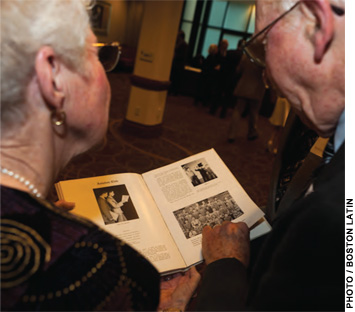
At a time when American education is striving to customize its offerings to students’ interests and needs, and to afford families more choices among schools and education programs, the market is pointing to the skimpy supply of schools of this kind. Moreover, if the best of such schools are hothouses for incubating a disproportionate share of tomorrow’s leaders in science, technology, entrepreneurship, and other sectors that bear on society’s long-term prosperity and well-being, we’d be better off as a country if we had more of them.
This challenge, however, goes far beyond the specialized world of selective high schools. It’s evident from multiple studies that our K–12 education system overall is doing a mediocre job of serving its “gifted and talented” youngsters and is paying too little attention to creating appealing and viable opportunities for advanced learning. What policymakers have seen as more urgent needs (for basic literacy, adequate teachers, sufficient skills to earn a living, for example) have generally prevailed. The argument for across-the-board talent development has been trumped by “closing the achievement gap” and focusing on test scores at the low end.
American education could and should be doing much more to help every youngster achieve all that he or she is capable of. A major push to strengthen the cultivation of future leaders is overdue, and any such push should include careful attention to the “whole school” model. Such institutions can develop a critical mass of instructional tools and equipment, financial resources, reputations, alumni/ae, and outside supporters that is hard to assemble for a smallish program within a comprehensive school. And the critical-mass effect is visible in the curriculum, too. Instead of isolated honors and AP classes, single-purpose schools can amass entire sequences at that level. They can also develop courses that go beyond AP offerings, do more with individual student projects, concentrate their counseling efforts on college placement, and muster teams of eager students (and teachers) for science competitions and the like.
Insofar as students benefit from peer effects in classrooms, corridors, and clubs, and insofar as being surrounded by other smart kids challenges these students (and wards off allegations of “nerdiness”), schools with overall cultures of high academic attainment are apt to yield more such benefits.
Finally, viewed as a community asset, having an entire school of this sort to show parents, colleges, employers, firms looking to relocate, real estate agents, and others can bring a kind of élan or appeal to a place that may also help with economic development, the retention of middle-class families, and more. It’s also a fact, however, that in times when resources are tight, communities and states are unlikely to hasten to create many more selective high schools, even where the reasons for doing so may be compelling.
Whether we deploy many more “whole schools” of this kind or opt mainly for specialized courses and programs within ordinary schools, the kinds of rigorous and advanced education that selective-admission schools seek to provide, and the youngsters that they serve, need to rise higher in our national consciousness and our policy priorities.
Chester E. Finn, Jr. is president of the Thomas B. Fordham Institute and senior fellow at Stanford University’s Hoover Institution. Jessica Hockett is an educational consultant specializing in differentiated instruction, curriculum design, and teacher professional development. This article is based on the authors’ forthcoming book, Exam Schools: Inside America’s Most Selective Public High Schools (Princeton University Press), a joint undertaking of the Hoover Institution’s Koret Task Force on K‒12 Education and the Thomas B. Fordham Institute.
This article appeared in the Fall 2012 issue of Education Next. Suggested citation format:
Finn, C.E., and Hockett, J. (2012). Exam Schools from the Inside Out: Racially diverse, subject to collective bargaining, fulfilling a need. Education Next, 12(4), 8-16.


